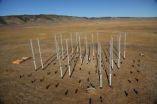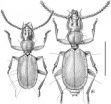(Press-News.org) A tiny plant called Arabidopsis thaliana just helped scientists unearth new clues about the daily cycles of many organisms, including humans. This is the latest in a long line of research, much of it supported by the National Institutes of Health, that uses plants to solve puzzles in human health.
While other model organisms may seem to have more in common with us, greens like Arabidopsis provide an important view into genetics, cell division and especially light sensing, which drives 24-hour behavioral cycles called circadian rhythms.
Some human cells, including cancer cells, divide with a 24-hour rhythm. One of the main human circadian rhythm genes, cryptochrome, has been associated with diabetes and depression. Both of these discoveries grew from work with plants.
"We don't have stems and we don't flower, but our body parts, like those of plants, are controlled by circadian clocks," says NIH geneticist Laurie Tompkins. "Clocks operate more or less the same way in all organisms, but some aspects of clock function are easier to study in plants."
The new work, released this week in the early online publication of Nature, investigated why Arabidopsis does its major stem-growing in the dark—a pattern common to most plants. Biologist Steve Kay and colleagues at the University of California, San Diego, report that a specific trio of proteins regulates the rhythm in Arabidopsis stems.
The group of proteins, called the evening complex, interacts in the early evening to silence two genes that usually promote plant growth. When the evening complex's activity trails off a few hours before dawn, proteins release the brakes on growth and plants enter their nightly phase of rapid stem elongation.
When Kay's team mutated the three genes that code for the evening complex, they noticed that this made the Arabidopsis biological clock run out of sync—stems grew unusually long and flowered early.
Scientists aren't yet certain why night is the best time for stems to grow, but Kay speculates it has to do with using resources efficiently. Plants pick up carbon and nitrogen during the day, then store these essential nutrients as starch and proteins. "In the later night, they can release these resources in a coordinated fashion to provide the building blocks for stem growth," says Kay.
"Our understanding of human health and the role of clocks in health and disease can greatly benefit from studying how clocks work in plants," he adds.
Kay's work could also shed light on how clock genes regulate cell division in human embryos.
From Crops to Cures
Scientists like Kay are interested in answering basic biological questions, but others who work with plants have their eyes on future disease therapies.
Plant-based molecules, for instance, are being used to target reservoirs of HIV that hide out in their hosts. At the University of California, Berkeley, chemist Jay Keasling is looking for simple ways to get microbes to produce greater quantities of these plant-based molecules at lower cost.
How plants like Arabidopsis suppress harmful genes may also help improve HIV therapies. A team of biologists led by Craig Pikaard at Washington University in St. Louis is investigating RNA polymerases, chemicals important in determining which genes get switched on, to learn how plants silence harmful virus-derived genes. Similar silencing pathways could be harnessed for HIV therapies.
More generally, scientists are looking toward plants as a medicinal source. Chemist Sarah O'Connor at MIT is genetically engineering periwinkle plants, the natural source of the anticancer drug vinblastine, to produce variations of the drug with halogens attached. Halogens make some medicines last longer in the body, meaning that probing periwinkle's capabilities could make cancer treatments more effective.
###
Learn more:
Circadian Rhythms Fact Sheet:
http://www.nigms.nih.gov/Education/Factsheet_CircadianRhythms.htm
Model Organisms Fact Sheet:
http://www.nigms.nih.gov/Education/modelorg_factsheet.htm
1 more way plants help human health
2011-07-14
ELSE PRESS RELEASES FROM THIS DATE:
Natural gas produced from fine milling of precious metals
2011-07-14
Roger Anderson, President of X9 Gold Development, Inc., announced today that multiple tests conducted over the past 18 months have demonstrated that carbon in precious metal ores can be converted to natural gas (methane) during fine milling utilizing X9 Gold's Bubble Mill Technology.
"Over 250 milling processes on a variety of ores have yielded the production of natural gas (methane) as a by-product of the milling process. The amount of natural gas generated seems to be in direct proportion to the carbon content of the ore. "
Mr. Anderson also explained that, "The ...
VOICE study will continue as it considers what action to take after results of 2 trials
2011-07-14
PITTSBURGH, July 13, 2011 – Today, researchers from two major HIV prevention trials announced favorable results of an approach called oral pre-exposure prophylaxis, or PrEP. One of these trials, the Partners PrEP Study, has provided the strongest evidence yet of PrEP's effectiveness.
Information from both studies will need to be fully evaluated before it can be determined what impact they will have on another major trial that is ongoing. Investigators for VOICE – Vaginal and Oral Interventions to Control the Epidemic, and the study's sponsor, the National Institute ...
Pivotal study in Africa finds that HIV medications prevent HIV infection
2011-07-14
In a result that will fundamentally change approaches to HIV prevention in Africa, an international study has demonstrated that individuals at high risk for HIV infection who took a daily tablet containing an HIV medication – either the antiretroviral medication tenofovir or tenofovir in combination with emtricitabine – experienced significantly fewer HIV infections than those who received a placebo pill. These findings are clear evidence that this new HIV prevention strategy, called pre-exposure prophylaxis (or PrEP), substantially reduces HIV infection risk.
The study ...
Wind-turbine placement produces tenfold power increase, Caltech researchers say
2011-07-14
PASADENA, Calif.—The power output of wind farms can be increased by an order of magnitude—at least tenfold—simply by optimizing the placement of turbines on a given plot of land, say researchers at the California Institute of Technology (Caltech) who have been conducting a unique field study at an experimental two-acre wind farm in northern Los Angeles County.
A paper describing the findings—the results of field tests conducted by John Dabiri, Caltech professor of aeronautics and bioengineering, and colleagues during the summer of 2010—appears in the July issue of the ...
Separated for 20 million years: Blind beetle from Bulgarian caves clarifies questions
2011-07-14
One of the smallest ever cave-dwelling ground beetles (Carabidae), has recently been discovered in two caves in the Rhodopi Mountains, Bulgaria, and described under the name Paralovricia beroni. The beetle is completely blind and is only 1.8-2.2 mm long. The study was published in the open access journal ZooKeys.
"When we saw this beetle for first time, it became immediately clear that it belongs to a genus and species unknown to science. Moreover, its systematic position within the family of Carabidae remained unclear for several years. After a careful study of its closest ...
UAB researchers present a study on the psychological adaptation of adopted children
2011-07-14
Over 4,000 international adoptions take place in Spain every year. Although the process of adaptation of these children is very similar to that of those living with their biological parents, some studies show that they are more prone to being hyperactive, to having behavioural problems, a low self-esteem and doing poorly in school. A group of researchers at UAB carried out a psychological study aimed at examining adaptation among adopted children with a sample of 52 children from different countries aged 6 to 11, and a control group of 44 non adapted children. Countries ...
Localized reactive badger culling raises bovine tuberculosis risk, new analysis confirms
2011-07-14
Localised badger culling in response to bovine tuberculosis (TB) outbreaks increases the risk of infection in nearby herds, according to a new analysis.
The study, by researchers at the Medical Research Council Centre for Outbreak Analysis and Modelling at Imperial College London, is published today in the Royal Society journal Biology Letters.
The findings come as the Government prepares to decide whether to license farmers to organise the widespread culling of badgers over areas of 150 square kilometres or more in western England.
Bovine TB is a major animal health ...
One-third of central Catalan coast is very vulnerable to storm impact
2011-07-14
Researchers from the Polytechnic University of Catalonia (UPC) have developed a method for evaluating the vulnerability of coastal regions to the impact of storms. The method, which has been applied on the Catalan coastline, shows that one-third of the region's coasts have a high rate of vulnerability to flooding, while 20% are at risk of erosion.
"Until now there was no tool for evaluating coastal storm vulnerability that could quantify the processes and the probabilities of these events occurring. This is why we have developed a method to allow coastal managers – the ...
Fewer aphids in organic crop fields
2011-07-14
Farmers who spray insecticides against aphids as a preventative measure only achieve a short-term effect with this method. In the long term, their fields will end up with even more aphids than untreated fields. This has been reported by researchers at the Biocenter of the University of Würzburg in the scientific journal PLoS One.
What's the status of the biodiversity in differently managed triticale fields? This is what the biologists at the Department of Animal Ecology & Tropical Biology wanted to find out. Triticale is a cross between wheat and rye. The cultivation of ...
Santa Monica Cosmetic Dentists Maintain Dental Education Outside Office
2011-07-14
For 35 years Drs. Roger Lent and Brett Lent of Lent Family Dental, dentists in Santa Monica, have been providing the highest quality dental care to patients in the Santa Monica area. Striving to educate patients about their oral health and treatment options, Lent Family Dental is now helping patients make well-informed decisions about their dental health care through the use of educational resources on their website.
New educational resources include a vast dental library and staff section, to learn more about dental problems and treatments currently available, as well ...



